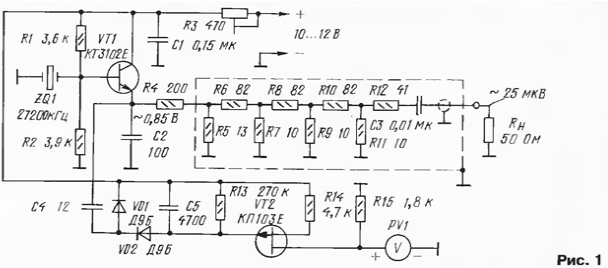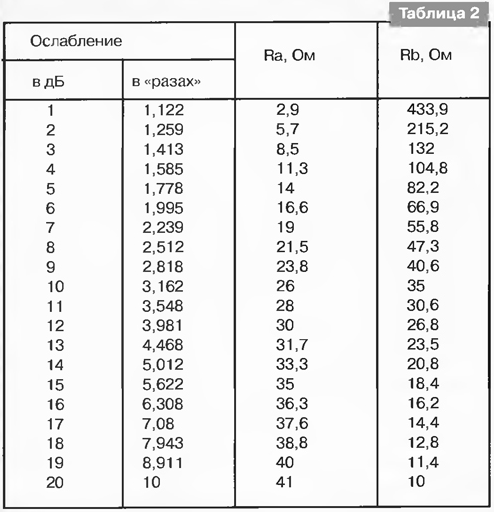
|
|
ENCYCLOPEDIA OF RADIO ELECTRONICS AND ELECTRICAL ENGINEERING S-meter calibrator. Encyclopedia of radio electronics and electrical engineering
Encyclopedia of radio electronics and electrical engineering / Civil radio communications This article describes an easy-to-manufacture device that allows you to calibrate the dial S-meter of a CB radio station, as well as correct the readings of a regular S-meter. The strength of the received radio signal is usually evaluated in points - from 1 to 9. A signal change by one point corresponds to a twofold change in the voltage at the receiver input (by 6 dB). A signal of nine points corresponds to a voltage of 50 μV (with a receiver input impedance of 50 ohms and frequencies below 30 MHz). If the level is higher than nine points, then it is designated, for example, as follows: S9 + 10 dB, S9 + 30 dB, etc. In table. 1 shows the scale of the S-meter in points and the level of high-frequency voltage at the antenna input of the radio station. S-meter allows you to evaluate the level of the received signal. In CB radio stations entering our market, S-meters most often do not correspond to the accepted scale. It is not difficult to correct the S-meter readings; for this, the stations have a special tuning resistor, but this can only be done using a high-frequency generator with an attenuator. In the Yosan 2204 radio, for example, this is done with a VR602 resistor. There are S-meters, the readings of which can be set in accordance with Table. 1 only at certain points. This is a design defect. In modern stations, it is usually unremovable.
On fig. 1 shows a diagram of an easy-to-manufacture device, using which you can check and. if necessary, correct the S-meter reading. A generator is assembled on the transistor VT1. Its frequency is set by a quartz resonator ZQ1. It should, of course, be in the operating frequency range of the station, better - in its middle.
The high frequency voltage at the emitter of the transistor VT1 depends on the supply voltage. Resistors R4 - R12 are a normalized attenuator (attenuator) of the high-frequency signal, which reduces the RF voltage from 0,85 V at the input to 25 μV at the output. A radio station is connected to the output (RH in the diagram). Thus, a signal with a voltage of 25 μV (8 points) is supplied to the input of the radio station receiver. On the diodes VD1, VD2 and the transistor VT2, an RF voltmeter is assembled, which allows you to set the RF voltage at the emitter VT1 to 0.85 V. This is done with a tuning resistor R3. PV1 is a digital or pointer voltmeter with an input resistance of more than 100 kOhm in the DC voltage measurement mode. On fig. 2 shows the circuit board of the device. It is made of double-sided foil fiberglass with a thickness of 1,5 mm. On the one hand, the foil is used only as a screen and a common wire (the negative terminal of the power source is connected to it). To skip the conclusions of the parts in the foil, ring-shaped samples are made. The connection points of the "grounded" terminals are shown as black squares. The attenuator is separated from other elements by a screen - a strip of tin with a height of 7 ... 8 mm, soldered to the foil of a common wire. The screen position is shown with a dashed line.
All resistors are MLT-0,125 or similar of the same power (C2 - 23, OMLT, etc.). Resistors R4 - R12 must be non-wire. Wirewound resistors and resistors with a conductive layer in the form of a spiral cannot be used: they have a significant inductance. Resistors for the attenuator must be selected using a digital ohmmeter. The installation of random resistors that only nominally have the required resistance can lead to the fact that the attenuator attenuation will differ from the calculated one by 30 ... 40% or more. The ZQ1 quartz resonator must operate at the fundamental frequency. On such resonators, it is customary to indicate the frequency in kilohertz (kHz), and not in megahertz (MHz), as in those excited at the harmonic of the fundamental frequency. In order to avoid possible disruption of oscillations, it is better not to connect the resonator case to anything. The assembled board must be placed in a metal box of suitable dimensions (for example, from under bouillon cubes). The calibrator is connected to the antenna input of the radio station with a short coaxial cable with an appropriate connector on the end. The output signal level may be different. But for this, the attenuator will need to be modified. Let's present the attenuator in a different form (Fig. 3a). It has four T-sections that are easily visible. The first, unbalanced, is made up of resistors R4, R5 and R6'. It has an output impedance of 50 ohms, which is equal to the input impedance of the second section. The first section steps down the RF voltage from 0,85V to 25mV. The second, third and fourth sections are symmetrical and identical: each of them has an input and output impedance of 50 Ω and contributes 20 dB to the total attenuation (Fig. 3b and Table 2).
Any of these three sections can be tuned to some other attenuation. It will only be necessary to replace Ra and Rb in it as indicated in Table. 2. Since the input and output resistance of the section remains unchanged - these are the same 50 Ohms, installing new Ra and Rb will not affect the attenuation introduced by other sections of the attenuator. Thus, having somehow changed the attenuation in the section, we will change the attenuation of the entire attenuator by the same amount. More details about the calculation of attenuators can be found in [1].
For example, to halve (by voltage) the attenuation of the last section (from 20 to 14 dB), you need to set it in accordance with Table. 2 R10" = R12 = 33,3 ohms and R11 = 20,8 ohms. Thus, we will raise the signal level at the input of the radio station to 50 μV, i.e. up to 9 points. After making certain changes in the section, you can return to the old structure of the attenuator. Instead of two resistors in series, you only need to install one with a resistance equal to the sum of the resistances of the individual resistors. Thus, the calibrator shown in Fig. 1 will give 9 points if you set R10 \u74,3d 41 ohms (33,3 + 11, 20,8), R12 = 33,3 ohm and R0 = XNUMX XNUMXm. In conclusion, we note that the lower the voltage at the output of the calibrator, the more relevant its shielding becomes. She must be especially careful when she needs to calibrate the S-meter reading at the very beginning of the scale. By using the variable attenuation attenuator described in [2], it is possible to calibrate the pointer S-meter with high accuracy. Literature
Author: Yu.Vinogradov, Moscow
A New Way to Control and Manipulate Optical Signals
05.05.2024 Primium Seneca keyboard
05.05.2024 The world's tallest astronomical observatory opened
04.05.2024
▪ The internet is bad for trees ▪ Chickens talk about geographical discoveries
▪ section of the site Electrical safety, fire safety. Article selection ▪ article Greenhouse dugout. Tips for the home master ▪ article How did the famous singer Orpheus die? Detailed answer ▪ article Cargo trailer for a car. Personal transport ▪ article Quacking Duck Simulator. Encyclopedia of radio electronics and electrical engineering ▪ article Uzbek proverbs and sayings. Large selection
Home page | Library | Articles | Website map | Site Reviews www.diagram.com.ua |






 Arabic
Arabic Bengali
Bengali Chinese
Chinese English
English French
French German
German Hebrew
Hebrew Hindi
Hindi Italian
Italian Japanese
Japanese Korean
Korean Malay
Malay Polish
Polish Portuguese
Portuguese Spanish
Spanish Turkish
Turkish Ukrainian
Ukrainian Vietnamese
Vietnamese





 Leave your comment on this article:
Leave your comment on this article: